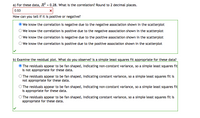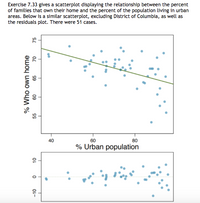
MATLAB: An Introduction with Applications
6th Edition
ISBN: 9781119256830
Author: Amos Gilat
Publisher: John Wiley & Sons Inc
expand_more
expand_more
format_list_bulleted
Concept explainers
Question

Transcribed Image Text:a) For these data, R? = 0.28. What is the correlation? Round to 2 decimal places.
0.53
How can you tell if it is positive or negative?
OWe know the correlation is negative due to the negative association shown in the scatterplot
O We know the correlation is positive due to the negative association shown in the scatterplot
O We know the correlation is negative due to the positive association shown in the scatterplot
O We know the correlation is positive due to the positive association shown in the scatterplot
b) Examine the residual plot. What do you observe? Is a simple least squares fit appropriate for these data?
O The residuals appear to be fan shaped, indicating non-constant variance, so a simple least squares fit
is not appropriate for these data.
O The residuals appear to be fan shaped, indicating constant variance, so a simple least squares fit is
not appropriate for these data.
O The residuals appear to be fan shaped, indicating non-constant variance, so a simple least squares fit
is appropriate for these data.
O The residuals appear to be fan shaped, indicating constant variance, so a simple least squares fit is
appropriate for these data.

Transcribed Image Text:Exercise 7.33 gives a scatterplot displaying the relationship between the percent
of families that own their home and the percent of the population living in urban
areas. Below is a similar scatterplot, excluding District of Columbia, as well as
the residuals plot. There were 51 cases.
40
60
80
% Urban population
% Who own home
-10
55
65
75
09
OL
Expert Solution
This question has been solved!
Explore an expertly crafted, step-by-step solution for a thorough understanding of key concepts.
This is a popular solution
Trending nowThis is a popular solution!
Step by stepSolved in 3 steps

Knowledge Booster
Learn more about
Need a deep-dive on the concept behind this application? Look no further. Learn more about this topic, statistics and related others by exploring similar questions and additional content below.Similar questions
- Distinguish the correlation shown in the graph below. Summarize why it is the chosen correlation. 30 Use the paperclip button below to attach files. Student can enter max 3000 characters 1- XD 2= DELL to B I U 25 de 2arrow_forwardHow does multiplying each score by a (positive) constant affect the value of the correlation? The correlation changes sign. The correlation does not change. The correlation decreases. The correlation increases.arrow_forwardNeed the first 3arrow_forward
- Use the data values in the table below to calculate the correlation between the variables x and y.Submit the link through Canvas to either a photo of your work on paper or a link to a google sheet. x y 5 15.3 6 20.06 7 21.42 8 24.18 9 28.64 10 31.5 11 31.86 Give your answer to three decimal places.arrow_forwardHow strong is this relationship? Obtain the correlation. (Provide your answer to four decimal places.) r=arrow_forwardSolve this example in the picture below, read the question carefully and answer it correctly. Please solve the work accurately and make sure that you check your work, this deals with correlations.arrow_forward
arrow_back_ios
SEE MORE QUESTIONS
arrow_forward_ios
Recommended textbooks for you
 MATLAB: An Introduction with ApplicationsStatisticsISBN:9781119256830Author:Amos GilatPublisher:John Wiley & Sons Inc
MATLAB: An Introduction with ApplicationsStatisticsISBN:9781119256830Author:Amos GilatPublisher:John Wiley & Sons Inc Probability and Statistics for Engineering and th...StatisticsISBN:9781305251809Author:Jay L. DevorePublisher:Cengage Learning
Probability and Statistics for Engineering and th...StatisticsISBN:9781305251809Author:Jay L. DevorePublisher:Cengage Learning Statistics for The Behavioral Sciences (MindTap C...StatisticsISBN:9781305504912Author:Frederick J Gravetter, Larry B. WallnauPublisher:Cengage Learning
Statistics for The Behavioral Sciences (MindTap C...StatisticsISBN:9781305504912Author:Frederick J Gravetter, Larry B. WallnauPublisher:Cengage Learning Elementary Statistics: Picturing the World (7th E...StatisticsISBN:9780134683416Author:Ron Larson, Betsy FarberPublisher:PEARSON
Elementary Statistics: Picturing the World (7th E...StatisticsISBN:9780134683416Author:Ron Larson, Betsy FarberPublisher:PEARSON The Basic Practice of StatisticsStatisticsISBN:9781319042578Author:David S. Moore, William I. Notz, Michael A. FlignerPublisher:W. H. Freeman
The Basic Practice of StatisticsStatisticsISBN:9781319042578Author:David S. Moore, William I. Notz, Michael A. FlignerPublisher:W. H. Freeman Introduction to the Practice of StatisticsStatisticsISBN:9781319013387Author:David S. Moore, George P. McCabe, Bruce A. CraigPublisher:W. H. Freeman
Introduction to the Practice of StatisticsStatisticsISBN:9781319013387Author:David S. Moore, George P. McCabe, Bruce A. CraigPublisher:W. H. Freeman

MATLAB: An Introduction with Applications
Statistics
ISBN:9781119256830
Author:Amos Gilat
Publisher:John Wiley & Sons Inc

Probability and Statistics for Engineering and th...
Statistics
ISBN:9781305251809
Author:Jay L. Devore
Publisher:Cengage Learning

Statistics for The Behavioral Sciences (MindTap C...
Statistics
ISBN:9781305504912
Author:Frederick J Gravetter, Larry B. Wallnau
Publisher:Cengage Learning

Elementary Statistics: Picturing the World (7th E...
Statistics
ISBN:9780134683416
Author:Ron Larson, Betsy Farber
Publisher:PEARSON

The Basic Practice of Statistics
Statistics
ISBN:9781319042578
Author:David S. Moore, William I. Notz, Michael A. Fligner
Publisher:W. H. Freeman

Introduction to the Practice of Statistics
Statistics
ISBN:9781319013387
Author:David S. Moore, George P. McCabe, Bruce A. Craig
Publisher:W. H. Freeman